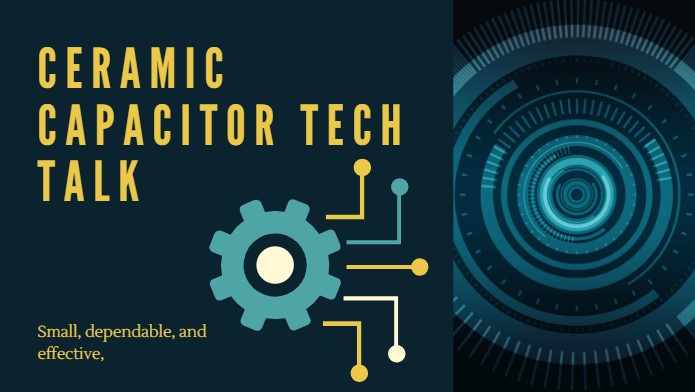Ceramic Capacitors Tech Talk :
An Overview The technology talk on ceramic capacitors
Focuses on how these essential components drive contemporary electronics. Because they are small, dependable, and effective, they serve as the foundation for circuit design. Engineers use them to control the flow of energy, filter signals, and keep device voltage levels stable. This technical talk on ceramic capacitor tech talk examines how their adaptability to a wide range of frequencies and environments has made them indispensable to a variety of industries, including aerospace and consumer electronics. A design of this kind makes stability, low cost, and excellent performance possible. Engineers appreciate them for this reason because they function effectively across temperature ranges. In today’s advanced technological landscape, the readers of the ceramic capacitor tech talk will gain a better understanding of why these capacitors remain the primary choices that designers make in search of dependable, compact, and inexpensive circuit solutions.
Understanding Ceramic Capacitor Basics
The fundamental use of ceramic capacitor tech talk material as a dielectric in ceramic capacitors is explained in basic ceramic capacitor technical talk. Two conductive plates are separated by a ceramic layer, allowing charge to accumulate. Such a simple yet powerful design makes ceramic capacitors suitable for a wide array of applications. The capacitance is higher when the dielectric is thinner, but it can handle lower voltages. In turn, a layer that is thicker can handle higher voltage but stores less charge. According to technical discussions, ceramic capacitor tech talk come in a variety of classifications, ranging from Class 1 for high-precision applications to Class 2 for general-purpose applications. Their value to engineers comes from their ability to perform consistently over time. ceramic capacitor tech talk connects electrical engineers’ daily design needs with theoretical knowledge.
Types of Ceramic Capacitor Tech Talk
Types and Classifications Ceramic capacitor tech talks very often dwell on their two main classifications, namely Class 1 and Class 2. Class 1 capacitors are usually of the C0G or NP0 types, which boast high accuracy and thermal stability. On the other hand, Class 2 capacitors are typically X7R or Y5V and have a higher capacitance but lower stability. Ceramic capacitor tech talks elucidate how engineers select types based on their circuits. Class 1 is used in precision circuits, while Class 2 is used in general applications. Because they are non-polarised, these kinds of capacitors can be connected in any direction in a circuit. Multilayer designs that offer increased capacity without increasing size are also mentioned in the ceramic capacitor technology talk. Electronics miniaturisation trends are helped along by this. Ceramic capacitor tech talk can teach professionals about a number of important quality.
Also read: Cass Tech Football
Applications of Ceramic Capacitors Tech Talk in Modern Electronics
The use of ceramic capacitors in a variety of applications, such as regulating voltages and rejecting noise in circuits to stabilise power and safeguard automotive sensors, is demonstrated by ceramic capacitor tech talk about them. It makes it possible for fragile medical devices to transmit signals reliably. . According to ceramic capacitor tech talk, they dominate high-frequency circuits due to low parasitic inductance. Engineers like these capacitors because they deliver consistent results even when the component is subjected to mechanical or thermal tension. They also support renewable energy systems by making the power conversion of electronic systems smoother. According to Tech Talk, the adaptability and performance of ceramic capacitor tech talk make them the foundation for today’s rapidly expanding technology ecosystem, ensuring precision, dependability, and long life in modern electronics.
Advantages of Ceramic Capacitor Technology
Ceramic capacitor tech talk underlines several advantages, including compact size, high reliability, and economic efficiency. These capacitors work well across a wide temperature range and have very little leakage. The strong frequency characteristics and quick response time of ceramic capacitors are discussed in tech talk. They are built with multiple layers, so they fit on printed circuit boards without taking up any extra room. These components’ long shelf lives and low maintenance requirements are another benefit. Ceramic capacitor tech talk points to their resistance against moisture and vibration and is ideal for harsh environments. They do not dry out, as seen in electrolytic capacitors, nor do they require polarity checks. According to engineers, this is a very flexible product and can easily be integrated into automated assembly lines. Users are assisted in comprehending how this durability translates into improved product longevity by ceramic capacitor tech talk.
Challenges and Restrictions in ceramic capacitor tech talk
Ceramic capacitor tech talk The capacitance value of ceramic capacitors may fluctuate with temperature, voltage, and frequency, despite their numerous benefits, according to technical talk. In particular for Class 2 types, this nonlinear behaviour may have an impact on the signal’s stability. Micro-cracks caused by mechanical stress during soldering may result in actual performance drops, according to ceramic capacitor tech talk. Because of these issues, it is more difficult to achieve higher capacitance without sacrificing voltage rating. Ceramic capacitor tech talk has shown that while miniaturisation has its advantages, it increases the susceptibility to mechanical damage. This balancing of size, cost, and dependability remains difficult for designers. There is also a possibility of dielectric ageing reducing capacitance over time, although at a somewhat predictable rate. This is where ceramic sheds light on ongoing improvements in order to overcome these weaknesses. Engineers reduce problems by properly designing and testing circuits.
How manufacturing combines precision engineering and advanced materials
The process begins with the mixing of ceramic powder into a paste, which is then applied in thin layers. The stack is cut, compressed, and fired at a very high temperature to create a solid dielectric, according to Ceramic Capacitor Tech Talk. Current manufacturing techniques use automation to guarantee accuracy and consistencyCeramic capacitor tech talk also emphasises quality testing, including capacitance, resistance, and insulation. The investments in materials science result in performance increases of dielectrics. As a result, ceramics of high purity combined with optimised layering produce electrical properties that are unprecedented. Ceramic capacitor tech talk has demonstrated that innovations in production methods have allowed higher capacitance within smaller volumes, directly supporting trends toward miniaturised and efficient electronics in global markets.
Recent Development Trends and Innovations in Ceramic Capacitors
Ceramic capacitor tech talk keeps evolving with new material and production techniques. Today, engineers use nanotechnology to improve the stability and energy density of dielectric layers. According to technical talk about ceramic capacitors, applications for 5G and electric vehicles drive demand for capacitors with high reliability. New thin-film technology enables even smaller and more efficient components. Low-loss materials are being developed by manufacturers to further enhance high-frequency performance ceramic capacitor tech talk also focus on environmental friendliness, including waste reduction and lead-free materials. Automation and AI-based inspection. Ceramic capacitor tech talk are now in a position to become an essential enabler of new technologies thanks to this innovation. Tech talk about ceramic capacitors emphasises that designers want to meet these demands by increasing thermal resistance and energy efficiency.
Technology Talk: Ceramic Capacitor tech talk Future
Outlook The future of ceramic capacitor tech talk is promising, with continuous advances leading to innovation after innovation. With devices shrinking in size and increasing in power, the demand for high-density capacitors will continuously go up. Ceramic capacitor tech talk envisages that in the near future. Research focuses on new dielectric materials that offer higher capacitance without size compromise. Ceramic capacitor tech talk also foresees wider utilization in space tech.utilisation

